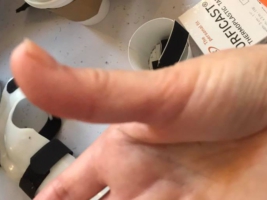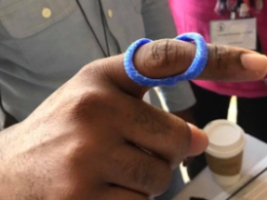Orthotic Intervention for the Elderly Patient
Orthotic interventions can benefit our elderly patients by protecting sore and inflamed joints, providing stability and support, correcting and/ or preventing contractures, and offering relief from pain.
When working with this population, the clinician must take into account each patient’s physical and cognitive status along with their ability to perform independent activities of daily living (ADL’s).
Before providing an orthosis, it is critical to consider what the specific goals of orthotic intervention are for the individual, and how they might help the individual continue to maintain independent functioning. Clinicians should assess each patient’s medical history, their unique living situation, and their cognitive abilities (including vision, hearing and speech). It is also important to note specific medications that are prescribed for the elderly patient as these can also affect wound healing, skin integrity, oedema, sleeping patterns (and therefore, orthotic wear during the night), and tremoring.
Orthoses fabricated for any purpose should be easy to put on and take off, be comfortable and simple in design, made from lightweight and breathable materials, and allow for maximum functioning.
In addition, the instructions for use must be carefully outlined and explained to the patient or caregiver; he or she should then be able to verbalize and/or demonstrate understanding.
Examples of orthoses that might benefit an elderly patient include:
- CMC orthosis for a patient with basal joint osteoarthritis.
- Thumb MP stabilization orthosis for a patient with subluxation of this joint.
- Trigger finger orthosis to block MCP joint flexion for a patient with flexor tenosynovitis.
- Anti swan neck orthoses for patients with hyperextension of the PIP joints due to arthritis or injury.
- Finger and/ or wrist orthoses that immobilize painful joints due to arthritic conditions.
- Orthoses that protect and support injured bones.
Helpful Hints for Providing Orthoses to the Elderly
- Provide pictorial instructions and/ or written instructions in large fonts.
- Provide instructions to caregivers and family members.
- Number the straps on the orthosis in an orderly manner.
- Apply the thermoplastic material to the end of the strap for an easier pinch.
- Use coloured straps so they do not get lost easily.
- Anchor the straps directly to the orthosis using the heat gun and additional thermoplastic material.
- Use coloured material and/ or coloured straps for patients with vision problems.
- Establish a routine for orthotic wear and keep the orthosis in a designated place when it is not being used.
- Instruct the patient or caregiver to monitor the skin for irritation and/ or red marks. The orthosis may need modification or suggest using a stockinet sleeve or sock be worn underneath the orthosis.
- Make sure the client or caregiver is able to take the orthosis on and off before leaving the clinic.
Thermoplastic materials that are favourable for the fabrication of orthoses for the elderly population.
Orfilight, Orfilight Atomic Blue NS and Orfilight Black NS are all designed specifically to be extremely lightweight materials. These products are offered in three thicknesses and different perforation patterns. Orthoses made from Orfilight products are comfortable and supportive without adding additional weight to the injured body part. Orfilight products feel light and foamy during the orthotic fabrication, but can be strong and maintain the exact desired posture when hardened. These products stretch and contour easily to the anatomy, making the fabrication process easier for all involved.
Orficast Thermoplastic Tape (in blue or black) is available in 2 widths while our new and thicker Orficast More (in blue or black) is available in three widths. Both Orficast and Orficast More offer the elderly patient an extremely comfortable, lightweight, and well-ventilated material option for their orthoses. Orthotic fabrication can be done quickly and easily for patients who might not be able to sit still for lengthy pattern making, moulding and modifying procedures. Orficast and Orficast More can be utilized to create a variety of hand- based and ulnar or radial gutter type orthoses without patterns. These materials are also lightweight in design and are quick and easy to use.
For more information on our various thermoplastic materials, ideas and orthotic design options, visit our product information and education page and learn through our videos and online (downloadable) Splinting Guide.
Reference
Riley MA, Lohman H. (2015). Orthotic Intervention for Older Adults. In Coppard BM, Lohman H. (Eds). Orthotics: A Clinical Reasoning and Problem Solving Approach. 4th Ed.(pp. 346-365). St. Louis, MO. Elsevier Mosby.
![]()

Written by Debby Schwartz, OTD, OTR/L, CHT
Physical Rehabilitation Product and Educational Specialist at Orfit Industries America.
Debby is a certified hand therapist with over 36 years of clinical experience. She completed her Doctorate of Occupational Therapy at Rocky Mountain University of Health Professions in 2010. She has worked at Orfit Industries America as Product and Educational Specialist since 2007.
Debby is also an adjunct professor at the Occupational Therapy Department of Touro College in NYC and has written many book chapters in the field of hand therapy and multiple articles for hand therapy journals, including the ASHT Times and the Journal of Hand Therapy. She has published a new textbook on orthotic fabrication together with Dr. Katherine Schofield, entitled “Orthotic Design and Fabrication for the Upper Extremity: A Practical Guide”.
![]()
Contact us for more product information or find your local distributor here.
![]()
If you’d like to receive the latest product updates and interesting Orfit news, subscribe to our newsletter:











